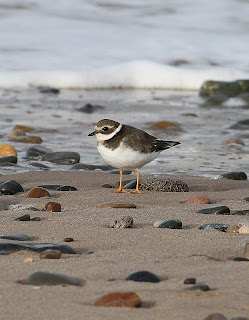No birding or ringing now for a couple of days. That old problem of the unkind elements I’m afraid, but the less said about that the better for now.
In between times I like to browse through old bird books, so as the rain hammered down on the conservatory roof I opened up ‘British Birds in their Haunts’ by The Reverend C.A. Johns, first published in 1862, and my copy revised as late as 1948.
In between times I like to browse through old bird books, so as the rain hammered down on the conservatory roof I opened up ‘British Birds in their Haunts’ by The Reverend C.A. Johns, first published in 1862, and my copy revised as late as 1948.
Often in these old books it’s the language itself that is intriguing, the use of long forgotten words or phrases, the rather stilted prose or often the realisation that not so many years ago birds were for collecting as trophies or for eating, not for looking at. Occasionally there is unique, long forgotten information that not only tells us about the bird but also documents social history. And of course there are the sometimes awful stylised plates, the sketches that were rather obviously usually drawn from the skins of shot birds or distant views obtained without the aid of binoculars or telescopes.

In the book I happened upon the pages for Ruff. Below I quote directly from the book, and whilst I will leave readers to make up their own minds about the paragraphs, it all makes for fascinating history. For me it also brings back memories of the old Ruff leck that used to take place on the River Ribble at Warton Marsh every year in the 1980s, where I would sit out of sight on the embankment, spellbound by the Ruff’s antics.

“Both the systematic names of this bird are descriptive of its quarrelsome propensities: philomacus is Greek for a “warrior”, pugnax Latin for “pugnacious”. Well is the title deserved for Ruffs do not merely fight when they meet, but meet in order to fight. The season for the indulgence of their warlike tastes is spring; the scene, a rising spot of ground contiguous to a marsh; and here all the male birds of the district assemble at dawn, for many days in succession and do battle valiantly for the females called reeves, till the weakest are vanquished and leave possession of the field to their more powerful adversaries. The attitude during these contests is nearly that of the domestic cock – the head lowered, the body horizontal, the collar bristling and the beak extended. But Ruffs will fight to the death on other occasions. A basket containing two or three hundred Ruffs was once put on board a steamer leaving Rotterdam for London. The incessant fighting of the birds proved a grand source of attraction for the passengers during the voyage; about half of them were slain before the vessel reached London. Ruffs are gluttonously disposed too, and if captured by a fowler will begin to eat the moment they are supplied with food; but however voracious they may be, if a basin of bread and milk or boiled wheat be placed before them it is instantly contended for; and so pugnacious is their disposition, that even when fellow captives, they would starve in the midst of plenty if several dishes of food were not placed amongst them at a distance from each other.
Many years have passed since these birds paid annual visits in large numbers to the fen countries, they were however highly prized as delicacies for the table, and their undeviating habit of meeting to fight a pitched battle gave the fowler such an excellent opportunity for capturing all the combatants in his nets, that they have been gradually becoming more and more rare. The fowler in fact has been so successful that he has destroyed his own trade.
Another peculiarity of the Ruff is that the plumage varies greatly in different individuals – so much so indeed that Montagu, who had an opportunity of seeing about seven dozen in a room together could not find two alike. These birds are now become rare, but occasional specimens are still met with in different parts of Great Britain, and at various seasons; but if they are ever served up at a table, they must be consignments from the Continent.”
What a shame I don’t have pictures of Ruff in breeding plumage. The ones below were taken at ‘CG’- Conder Green last autumn.


Do feel free to leave comments. Phil.

















































.jpg)

















